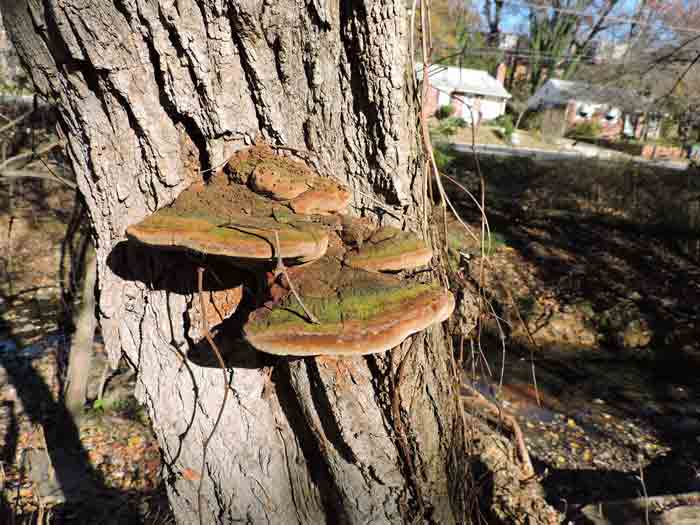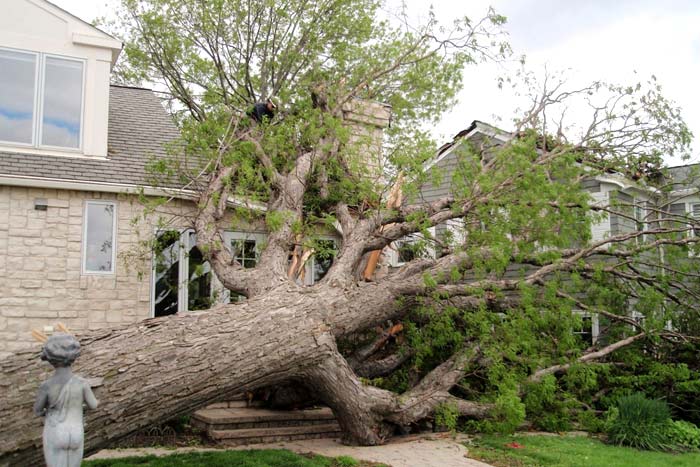Trees in suburbia all eventually become old and hazardous at some point. Healthy trees can also become a hazard quickly due to storm damage or a sudden change in root footings. A hazardous tree is any tree that poses an immediate danger to persons or property.
We take a look at how to assess if your tree needs emergency removal, how much a hazardous tree costs to remove, and if you need a permit.
What Does Hazardous Tree Removal Cost?
Expect to pay an average of $1.129 to have a hazardous tree removed professionally. The real range is between $450 for a small tree to $3,900 for extra-large trees. The amount you end up paying also depends on the type of tree to be removed, where it is located, how damaged it is, and when it is removed. For instance, giant oak trees generally cost more to remove as compared to American Elms.
To get an estimate from 3 local tree services, scroll to the top of the page, enter your Zip code, and a few details about your tree. Local companies will then send you bids on the cost of removal.

Average Cost to Remove A Hazardous Tree
| Service | Low | High |
|---|---|---|
| Hazardous tree removal cost | $450 | $3,900 |
| Hazardous tree removal per hour cost | $120 p/hr | $350 p/hr |
| Average cost of Hazardous tree removal | $1,129 | |
Average Estimate: $ 1,129
Do I Need A Permit to Remove A Hazardous Tree?
Permits are not required in most states to remove a hazardous tree. However, you will be required to have the tree inspected by a certified arborist and possibly the city arborist. A permit can take up to 4 weeks to obtain, so if a tree is an immediate threat, you can get the verbal go-ahead from the council. Others such as Houston, Tx1 allow tree owners to hire a private arborist who will inspect a tree and create a report that the tree is hazardous and should be removed.
You can avoid inadvertently breaking the law by consulting a tree removal company before you cut any tree even if you think it is a hazard. The tree removal company will ensure that they prepare the required documentation depending on your location and file it for you. The recommended tree removal companies in Go Tree Quotes have trained arborists and experience with local tree-cutting laws.

What Is Considered A Hazardous Tree?
Many reasons make a tree to be considered hazardous. Here are some of them:
- Dead or dying trees
- Rotting trees
- Storm-damaged trees
- Proximity to buildings and facilities
1. Dead or Dying Trees
A dead tree can easily tip over, lose its branches, or fall and hit nearby installations such as buildings, and garages and even injure passers-by. Dead trees are considered hazardous because the roots that keep them anchored to the ground are not weak and rotting. All dead trees fall over eventually, so they should be removed. Dead trees can be identified by the following characteristics
- Dry or rotten trunk
- Rotten or exposed roots
- Dead canopy with weak or hanging branches
- Rotten bark
- Leaning or shaky
- Hollow spots on the trunk, etc.
It can be difficult to tell if a mature tree is really dead or just dormant so having a trained arborist or dead tree service to have a look at it is recommended.
2. Trees with rot
Trees with internal rot in their trunk will eventually become a hazard. There are some telltale signs that a tree has internal rot. Bracket fungi2 grow on dead timber, so if you see bracket fungi growing on your tree trunk, (see image below) you will need to get it inspected by an arborist. The further down the trunk it is, the bigger the problem you have.

3. Storm damaged trees
Trees can quickly become dangerous after an extended period of heavy rain and wind. Rain softens the ground and wind can shift a tree so it develops a lean. When this happens, the tree in time could fall over.
Trees are great at reacting to a lean and sending out more stable roots to counter the lean, but this takes time. More wind or rain in the meantime could send the tree toppling over.

4. Tall Trees Next to Buildings, Roads, And Powerlines
Sometimes, a perfectly healthy tree can be considered hazardous if it’s too big and growing in a dangerous location such as next to a house, below a powerline, or next to a road. Such trees are usually trimmed or removed if they are deemed dangerous or if they block sunlight, powerlines, or other installations. Removing or significantly trimming a large tree is also part of the ways you can prepare your home for a storm or hurricane season.
Other signs that a tree is a potential hazard include:
- Sparse or unbalanced canopy
- Cracked trunks
- The tree has more than one trunk- divided trunks are more likely to rip or crack in rough weather.
- Mushrooms at the base of the tree, etc.





What Causes A Tree to Become Dangerous or A Hazard?
A tree can become dangerous or hazardous because of its health, structure, height, and its nature. An unhealthy tree with a rotten or dry trunk, weak branches, and a pest-infested canopy is a hazard because it can easily fall or lean over and block pathways or roads. If the tree is too tall and growing next to a building or powerline, then it becomes a hazard and may need to be cut or trimmed. Trees that are hazardous by nature- e.g. those with invasive roots or large fruits- are also considered hazardous or dangerous.
Some of the things that cause a tree to become a hazard can be managed or prevented. Regular trimming can help keep a tree’s height safe and also balance its canopy. Regular pruning3 can help get rid of hazardous dead or diseased branches and therefore make the tree safe. This is why homeowners should ensure that their trees are properly and regularly maintained as advised by a qualified arborist near them.
How Can I Tell If My Tree Is Hazardous?
There are numerous ways to tell if your tree is hazardous through observation even before you have an arborist inspect it.
- Developed a sudden lean – This can happen after long periods of rain and wind. The ground softens and the tree becomes unstable beginning to lean to one side.
- White ant activity – You never want white ants near your home, but having them in your tree can always be a problem for the trees’ stability. They will eat all the internal hardwood leaving only the outer living tissue. This can make the tree unstable and a hazard.
- Signs of rot – Look for bracket fungi on the trunk for signs of internal rot.
- Lifted root ball – After a storm and strong winds you might notice the root ball of a tree lifting. This is a sign the tree is unstable and needs to go.
- Houston Texas, (2009) Landscape Regulations for Development. <https://www.houstontx.gov/planning/DevelopRegs/docs_pdfs/tree_shrub.pdf> Accessed: 07-03-2024
- Andrew Scales, (2010) Wood Decay and Bracket Fungi. <https://www.naturallytrees.com.au/article/wood-decay-and-bracket-fungi> Accessed: 07-03-2024
- University Of Maryland, (2023) Pruning Trees in the Home Landscape. <https://extension.umd.edu/resource/pruning-trees-home-landscape/> Accessed: 07-03-2024







